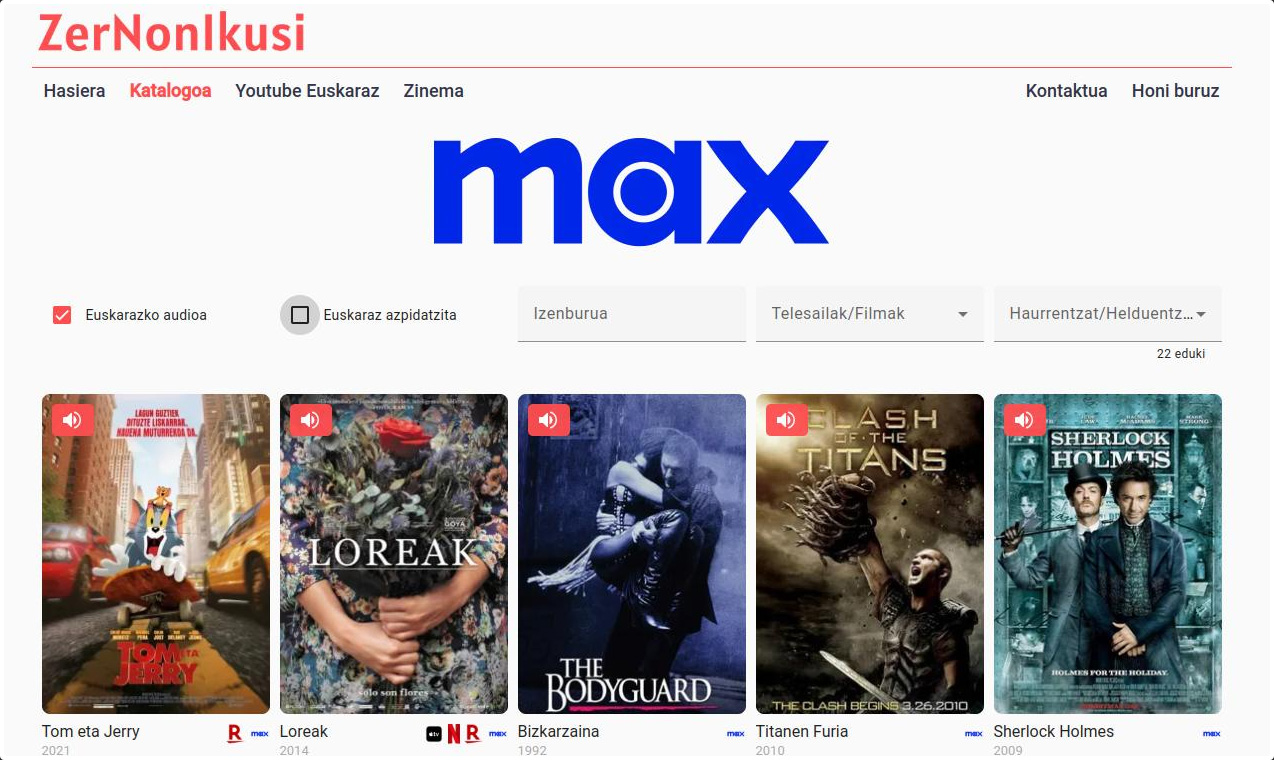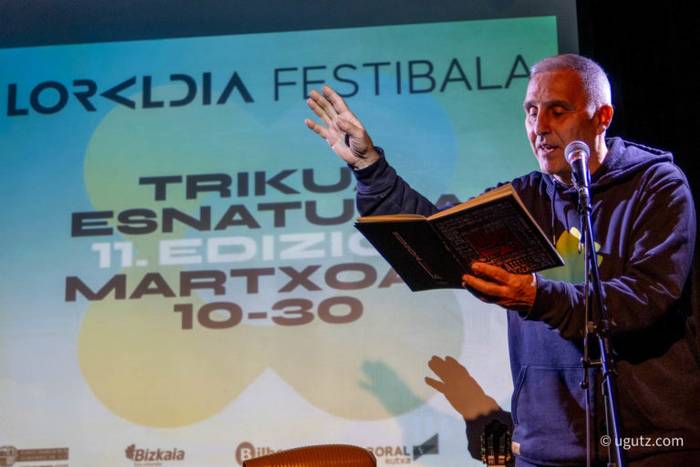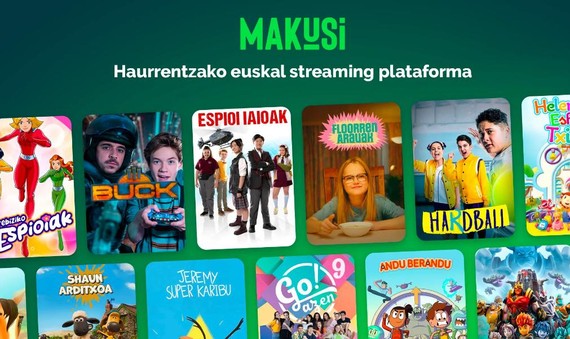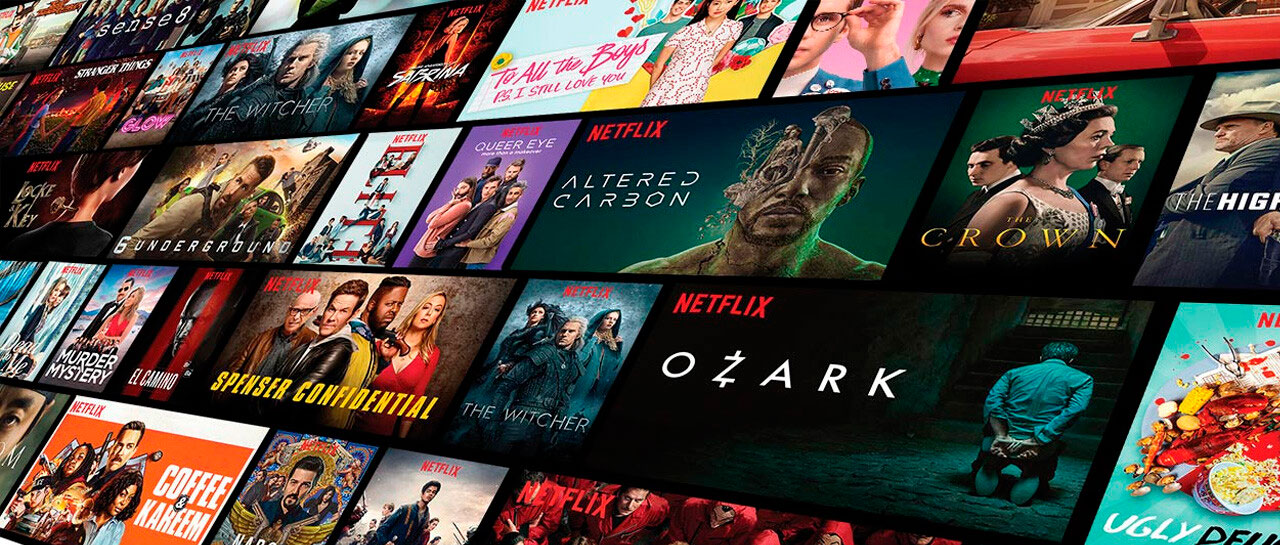"Let it be noted that some Basques have told the story of a Basque"
- The trio Moriarti has made a series of biographical fiction by designer Cristóbal Balenciaga for the Disney+ platform. It's their first format. ARGIA has been quoted with Aitor Arrangi and Jon Garaño, as Jose Mari Goenaga was out, working for a project they have in their hands.

[Currently they are immersed in two projects with several notes on the board. That's what we've pointed out.] You'll have a little forgotten about the Christopher Balenciaga series --
Aitor Arrangi: Yesterday, you told me that you were in Eroski, raising your arm, at a distance: "Hey, congratulations eh!" I think I've rarely felt so much happiness from people. They are congratulating me more
on Balenciaga than on others. They also congratulated us with others when we got the prizes, but not for the work itself. Jon Garaño: I have also noticed that people liked it, or I have the feeling that it has seen a lot. What happens is that Cristóbal Balenciaga had a house in San Sebastian until the end, with which many people have stories or experiences, if not directly, close. That one's grandmother worked there, a cousin's friend I don't know what...
Besides sewing, or at least more, their personal life is what they put in the center. And perhaps at the bottom is that over Cristóbal Balenciaga, as a person, there's not much information. Garaño: He wanted to be like this: to talk
about his work and not about him. The series focuses on this decision. We have reported and documented a lot, and what we have seen clearly is that he was struggling to make his work visible and to leave his personal being on another level. It was a contrast with almost all other designers for their fondness for prominence. Closing the doors had an opposite effect: people wanted to know something about him and she closed the doors even more. He didn't talk while he was active. Then, when she left, she gave two interviews, but both were very short. He certainly had great deals.
In the narrative line of the series you have departed
from an interview. Arrangi: We've made it a fiction. This dialogue was not in Igeldo, but in France. Not a full weekend, but an afternoon.
It takes a narrative device to be able to sort things out, and with quite a few laps in the head, it seemed to us that putting a conversation at the base would help us. It also serves to clarify this concept of the mystery of Balenciaga; in the end, a journalist asks why he decided to do one thing and not another, why he was left behind the curtain, why he closed the doors to the press, the way of working, not delegating responsibilities ...
For our part, more and more documented, we were more aware that his voice was missing. In other words, I had no opinion on this. So our exercise has been to put ourselves in the journalist's place and make hypotheses, asking this, or putting it in this situation, what response or what it would have done. It allowed us to put our doubts in the voice of the journalist and enrich history. Garaño: I'm going to say it as Spoiler. Behind or below there is one issue: the
need for Balenciaga to control everything.
How does a person's story build when there's little about their character? Garaño: There are books written by people around you, and that's also where we've thrown a lot. They tell you a little bit about what Balenciaga was like. And we've also met the people who met her. But of course, they met him when he was older. It is not the same when Balenciaga left for Paris fleeing the Civil War at the age of 40, than at the end of his career. Surely the person had a journey that we wanted to show. Let's put all the information collected in a cocktail party and create our Cristóbal Balenciaga. With
so much reading and listening, you can suspect, and all you have to do is build on those suspicions.
We have not mentioned it so far: the idea of making the series was not yours. It came to you. Arrangi: Lourdes
Iglesias proposed to tell us the more than 30 years Balenciaga spent in Paris. He had a great career here and in Spain before, but he saw him as the starting point on his journey. And so do we. But we didn't want to tell it chronologically, and based on the dialogue we've mentioned, which has become fiction, it was a good excuse to do so.

That is the basis of the interview, but several
topics have been addressed by chapters. Each chapter has its own theme. Arrangi: Dialogue gives you the general thread, and within it are some issues that are discussed in the whole series, but at the same time each chapter has to entertain. We're spectators of the series, but we've never done that exercise. In addition, we cannot forget that Balenciaga has had many things happening in Paris: he fled the Civil War, opened a new business, sought his own and differentiating style, suffered the Second World War and the Nazi occupation, with all the political conflict that this generates, there is also shock and stinging of the Dior and Balenciaga styles, copy of works, own wedding stories. The Crown series comes to me, in a chapter, from beginning to end, how does a painter's relationship with Churchill count?
Let us delve into the essence. You mentioned Balenciaga's need to control her entire work process, and it's interesting to see this way of working. In the last few years of her career, instead of making custom garments, many designers start producing large-scale. Balenciaga lived the moment of the clash of the two models. Arrangi: Ulertuta what happened to Balenciaga, in one way or another has happened in all sectors. And that is what most interested us in the Churches' proposal, that haute couture and the audiovisual world have parallels. You're in the old world, there's
a way to work, and suddenly comes another thing that happens to you. Or it adapts or cedes. Or you relay and maintain your way of working. It is something that happens a lot in film; the traditional way of making films and the model of big platforms collide. How are you in this new situation? This period clashed with Balenciaga when he was the main, at 72, to change him with few margins, deeply rooted in some ideas and certain ways of working. He rehearsed, like the story of Air France.
Jon Garaño: "Balenciaga struggled to make his work visible and leave his personal being on another level"
It clearly attaches particular importance to authorship. I felt that the garments with the brand Balenciaga were part of it. Garaño: We were told some anecdotes, how I could not see the clothes of the clients, made by himself, with a small hole, or without
putting them well... and that the chapel was to take that person, bring it home and sew and fix it by hand. This is very interesting to describe Balenciaga.
There's a topic, that in the movie or the picture you make you're camouflaged, that you feel like you're yours, that you're there, that you want to care for. What is creation, where the process ends, how to manage frustrations, obstacles, isolation, thoughts… We have channeled these issues into a creator like Balenciaga. He said he was an artisan and not an artist, but in the end his garments have so much personality and uniqueness that they make it an artist.

I don't know if you knew haute couture and that world before, but because the process is so long, you'll have learned a lot. I fix: on a scale from zero to ten, I've gone from
zero to zero coma eight [laughs]. I haven't learned too much about the technique, but I found it very interesting how that world works, or like you, parades, etc.
The rest of the process has been laborious. It's been two and a half years long. It's been a project of very large dimensions, like making almost three films at a time. We have been breathing more than once, in the case of realization, and we have had many moments of tension to plan the work. There was a lot to do: we had to make a world from scratch and, above all, clothing. You can't do anything with a Balenciaga, you can't make a ridicule. We have had an excellent costume team, and thanks to it, because there are many concrete things, because in each chapter there must be specific garments.
Have you seen the New Look series? [Around designer Christian Dior, located in Paris, also appears Balenciaga]. Garaño:
No, but we've read something.
It's an American series in which the occupation and prominence of the Nazis, the explosives, the things you can imagine -- very epic in this sense. Relocating the focus in relation to your work. Arrangi: Our hightlight moment was to record the
Nazi parade at night in the port of Donostia [laughs]. We would also put the bombs, but being epic goes with the budget. The New Look can cost 10 times more than ours. Garaño: We wanted to approach it from the business and psychological and political point of view of Balenciaga, because in addition to the budget, we felt more secure than with the costume. We were struck that during the Nazi occupation this activity continued. From what we read, Balenciaga had a conservative tone, but nothing got wet. He said he was “apolitical.” He had friends, until the end, of Franco's orbit; moreover, his last dress was for the wedding of Franco's granddaughter. And just the last dress, the one
on the other end: Vicente Ameztoy's wife. Balenciaga moved in an interested chaos. Arrangi: The question is whether you can be
apolitical in Nazi occupation. It is interesting that he talks with his partner Bizkargi, a Republican, who left the Civil War. At one point he tells Balenciaga, “Everything is political, even the hats you make.”
.jpg)
Netflix recently releases Piccaro, the documentary series Little Nicholas. Florentino Pérez is asked if it is PSOE or PP, and he says, “I am power.” Garaño: It is an apoliticity linked to power. Something that is in the ID of many people at that level, I'm now a friend of Aznar, now
Zapatero.
Alberto San Juan has done a great job of making Cristóbal Balenciaga that way. I fix: I can't imagine what it would be without him. Almost every scene. And he did have work, besides speaking French and Basque, with
no ideas in Basque and only in French. He worked with a teacher.
How did he get it? Garaño: It was funny because he was trying to practice the Basque language, and maybe he was talking to one of the groups, the Gernika group, and he asked the account to us: “This has told
me that it is said like this and so, not as you have told me.” We tried to explain that his character is getaria and doesn't do it the same. He told us that “we would forbid” or get him to talk to colleagues [laughs].
We have also worked euskararekin.Nahi the Basque of Getaria of the time we had, and has helped us a lot to adapt the language with me Kepa Iribar, a journalist from the Basque Country Irratia, who has made contrasts with a more mature family member of the family. Then, the Bizkaondo family [Balenciaga's partner, Basques] makes it easier for the Donostiarras.
Aitor Arrangi: "You're in the old world, there's a way to work, and all of a sudden comes another thing that happens over you."
And how has Disney taken Euskera? Garaño: They liked the idea
of making a series about Balenciaga, they wanted us to do it for our previous works, and they especially liked that they were Basque, because they could tell the story from here. The best thing to represent it is language, and we said importance to it. Disney liked that we wanted it that way, although I remember that at first we raised it with some fear.
Disney in the Spanish state has not doubled the film, but in France and in other countries. That is, in France everything is in French, as you can see in English in England, but in Spain they have kept the three languages with subtitles. A friendly actor told me to be attentive, that once premiered they wouldn't change it, because they had an experience with Movistar... Arrangi: The brand was going to
be later; it has little Basque and also double it. As bestas is Galician and they have become accustomed to it, they have opened the possibility of watching movies in Basque, they have been awarded… We were clear that the Basque country had to be introduced to show the connection of Balenciaga with his mother. I do not know what it says to one from Extremadura or Paris, but it tells us a lot. For us, the presence of the Basque Country and the history of the Basque Country were differential. Let it be noted that some Basques have told the story of a Basque, and not, with all respect, a Korean.
The Americans continue to do so as they did in their day. If the film is located in Russia, they speak English peacefully. And we are used to it, so we see it. You mentioned The New Look earlier, and there, as I read, you have done everything in English, despite being installed in Paris; English with French touches.

Disney puts the money. What kind of experience have you had? Arrangi: In general, and given what you hear from other platforms, we cannot complain. They have respected us very much. We understand that what we have done is our own work, even though we have been
forced into small things. In general, they have been reasonable. Disney had just started with us in Spain and now that three years have passed I think they too will have experience, it is normal.
I have heard something from the San Sebastian Film Festival -- Arrangi: It was actually brand new here, but from the US they decided to postpone it. In their logic it seemed to them brand new or not in the Zinemaldia. We told them it was a shame because it was done here, with the team here and because we created headaches in the Donostia traffic. It finally premiered a few
months later in Victoria Eugenia. Garaño: They have a lot of data. You know how many viewers have stopped watching the show in the eighth minute, or how many have only seen the first chapter. They are obsessed with it and are committed to making the first chapter particularly attractive. They have invested a lot of money and want it to go well.
Is it delivering good results? Garaño: They haven't given us data, that's the platform politics. They have only told us that they
are very happy about two things: that they have had a good premiere and that what they have seen has started and is over. The Guardian's criticism was very good and also in Germany, and so they're happy. We've been told these things by email.
More than one will wonder why ETB has not done the series, or at least because Balenciaga was Basque, and its image has often been repressed by the Basque institutions. It's true that the original idea was not yours, and it's been bought by Disney, but -- Garaño: The problem would be clearly the budget. This does not, in my opinion, detract from ETB’s responsibility to do the Basque series. I think
a big bet should be made. Arrangi: Now you will come and tell us that we do... Garaño: We would do them, but give us the resources we ask. I see it important to do adult series. Those who are doing it for children and young people are fine, I see them at home, they have their audience, it's the
Goazen phenomenon...
a few years ago a mini-series essay was done, almost all at once, suddenly, and there it was. Fortunately, I think there are some. I fix: I have the feeling that fiction gives a brand to the chain, as do concrete and informative programs. ETB may be behind a film, in funding, but I understand the film as something else, which will pass through the cinema. We need fiction series. It's expensive, but I think it's worth it. With fiction, you can tell something that's from here, like Alarde or Altsasu. We have tried to do so with Balenciaga. Garaño: Our elaboration and elaboration brings you great added value. For example,
Chernobyl did HBO, it was very successful, but they got angry in Russia and they did another series to tell it.
Jon Garaño: "To tell the story of a Basque from here, the best train is the Basque"
In Japan, they get angry with Oppenheimer
-- Garaño: Telling our stories is important. It's the way you're in the world.
I see on the board the names of two prospective projects. What do you have in your hands? Garaño: a film on the life of
Enric Marco, following statements made in 2005. We hope to have it completed by autumn. And then we started recording the other one, More pigeons. The first will
be in Spanish and Catalan, with a little bit of English and German and the other in Basque. Arrangi: It has taken us to finish one thing and put another thing in motion, and when we were finishing it with another… It is not usual, but it has been. Marco was ahead of Balenciaga.






















